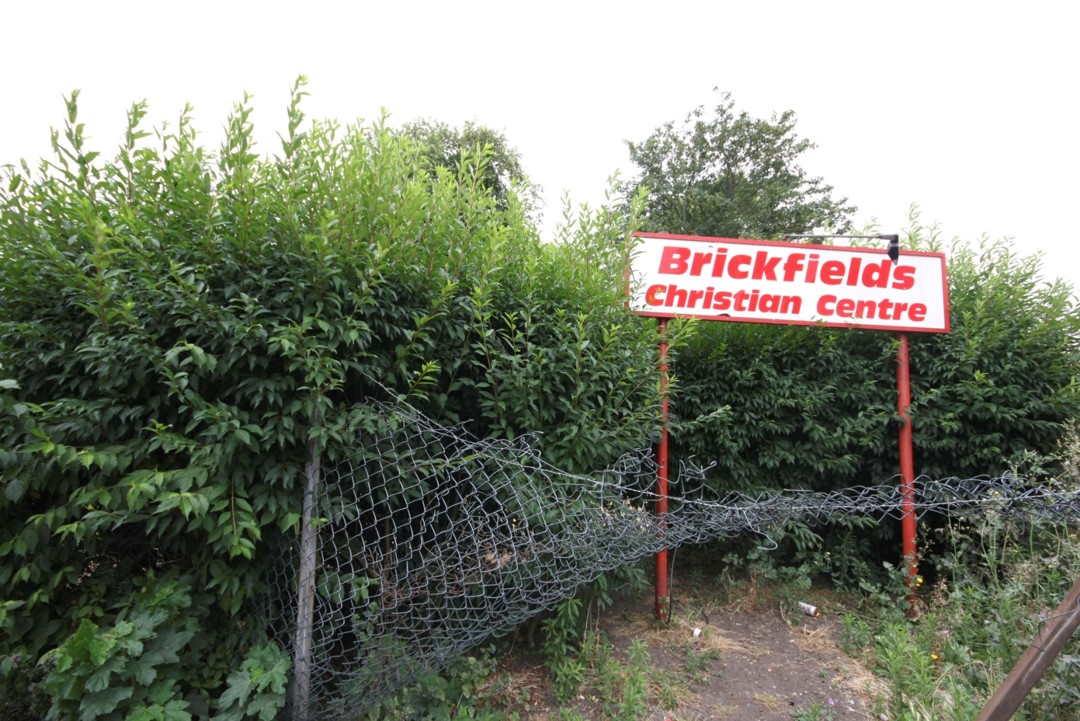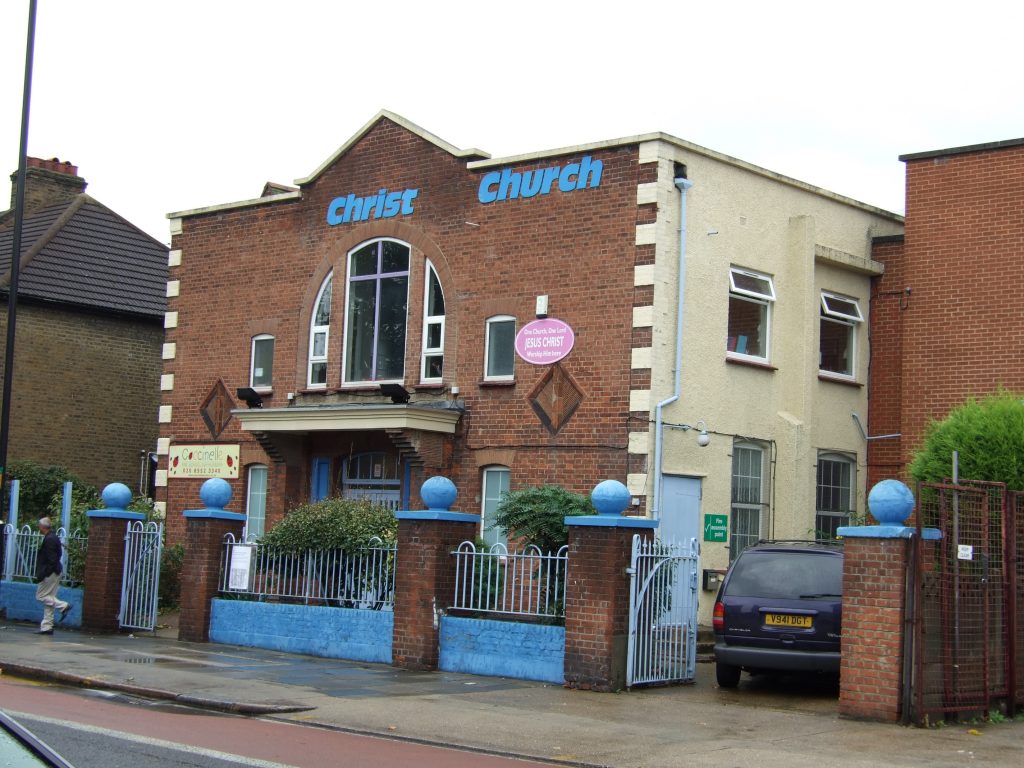United Reformed Church
The United Reformed Church was formed in 1972 by the merger of two denominations - Presbyterian and Congregational, dating from the 16th Century Protestant Reformation. By 2019 the 5 original Presbyterian and the 16 Congregational churches (with 11 missions) had shrunk to one URC church and 3 sites used by new churches.
A HISTORY OF THE UNITED REFORMED CHURCH IN NEWHAM.
Part 1 - The Presbyterian Church.
BACKGROUND
The Presbyterians, who in doctrine and Church government followed a similar pattern to the Church of Scotland, and the Congregationalists who stressed the importance of the local congregation both agreed to work together on the basis of their common evangelical, Free Church, tradition which centered on Biblical teaching.
There were four English speaking (usually with Scottish background) and one Welsh speaking congregation in Newham. At the URC merger in 1972 only Trinity, East Ave, East Ham remained; this quickly became a Community Centre under the Newham Community Renewal Programme.
A famous name associated with the Presbyterians was William Paton a local Minister who began the Darby and Joan Club; who also became West Ham ARP Controller, Councillor, and in 1952, Mayor of West Ham and was sometime candidate for MP for West Ham Labour party.
TRINITY CHURCH Leytonstone Road, Maryland Point, E15 [1863-1941]
A hall was built in 1864 and a church in 1870. The work flourished under with 400 members. From 1906 decline began. It closed in 1941. The church building was converted into a factory but was destroyed by fire 1953.
VICTORIA DOCKS, Hack Road, E16 (1872-1940).
Built by James Duncan, sugar refiner, to meet the needs of Scottish workers, the building was bombed early in the Second World War and not rebuilt.
SILVERTOWN, Tate Road, E16 (1882-1940)
Built by a local manufacturer it was bombed in the Second World War and not rebuilt.
EAST AVENUE, Manor Park E12 (1900- 1970s)
This church originated in 1890s. The East Avenue site was bought in 1900, 1903 saw a permanent church building erected. At that time there was a membership of 424 and under the ministry of I. Gwessin Jones (1910-28) this rose to 600 members.
Trinity, Maryland Point joined in 1941 and gave its name to East Avenue. The church hosted Wakefield Street Congregationalists 1941-45 after bomb-damage to their church. It became part of the URC from 1972. Eventually, the building was taken over by Newham Community Renewal Programme
PRESBYTERIAN CHURCH OF WALES, Romford Road, E15 (1890-1940)
Originated in 1890 and a building erected in 1894. Closed after bombing and became bedding factory.
Part 2 - The Congregational Church
In 2000 the URC Thames North Province had 44 churches within the A406 North Circular Road including Plaistow E13, Brickfields E15, New City E13, and Shalom E12.
In 2010 only one active URC congregation remained in Newham as the Brickfields E15 congregation joined Christ Church E13 and the URC involvement in the Shalom Centre E12 ceased. Three 'vested properties' continue to be used by other Christian congregations or agencies at New City Christian Centre E13; Brickfields E15 and Shalom Centre E12 and discussion continues on possible redevelopment.
CONGREGATIONAL CHURCHES AND MISSIONS IN NEWHAM
Famous Names associated with local Congregationalism were John Curwen (see John Curwen and the London Borough of Newham by Frank Sainsbury, 1980) and Rebecca Cheetham, founder and leader of Canning Town Women's Settlement
Notes on all the16 churches and 11 missions established within Newham follow; these show the development and decline and changes and influences that shaped all churches during the 350 years. The URC has known a massive decline from the hey-day around the 1900s when all the listed churches had been built. Some congregations, especially in the Stratford and Forest Gate areas, had membership and Sunday Schools in the thousands with extensive programmes within large buildings.
The sole Congregational continuation is in the partnership with the Methodists in the Pilgrims Way Church, E6
BRICKFIELDS CHRISTIAN CENTRE, Welfare Road, E15 (1662-2008)
This is the oldest Dissenting/Free Church congregation in Newham. When King Charles II in 1660 demanded an oath of allegiance to the crown and the signing of the 39 Articles of Faith over 2000 clergy refused and started new congregations - many of whom take 1662 as the date of founding. In Stratford the Church of England vicar, Thomas Walton, is reputed to have been involved in the beginning of Brickfields.


BALAAM STREET, Plaistow E13 (1807-1943)
This church had sites in North Street (1807-1860) and Balaam Street 1860-1943) when it joined Greengate. There was a Mission Hall in Southern Road established in 1887 with a Sunday School of 300.
John Curwen (1844-64) came to a 2000 strong village and had a significant ministry in population growth, adding a music academy and day school in 1844; services were held in Canning Town in 1851 and in retirement he helped found The Grove and Romford Road churches.
Membership 1882 was 225 and in 1901, 648. The building was enlarged to seat 1000. In 1891 there was a Sunday school of 1304. The high-water mark was 1902; the Year Book for that year provides a snapshot of a very busy church life, with 648 members. Activities on Sundays: Prayer Meeting at 10.00 a.m.; services 11.00 and 6.30 (also in Mission Hall). Services for children were held at 10.30 a.m., in the Church and Mission Hall; a Sunday school at 2.30. Lords Supper 3rd Sunday morning and 1st Sunday evening. Mondays: Mothers meetings at Church and Mission Hall; Christian Endeavour Society Meetings, Mission Hall Band of Hope. Tuesday Evangelistic Service 7.30 Mission Hall, Psalmody practice and Choral Society; Wednesdays: Prayer Meeting and Address; Thursday Sunday school teachers 1st week, then concerts and Entertainments. Friday: Gymnasium, Teachers Preparation. There were cricket and cycling clubs, Dorcas and Maternity Societies, Friendly Visitation, Society for Visiting and Relieving the Sick and Aged Poor
Thereafter decline came, although still fairly strong to 1939. The building was bombed 1939-45 war and abandoned in 1945. In 1943 members of Balaam Street and Southern Road united with Greengate, Barking Road to form Plaistow Congregational Church.
SEBERT ROAD, Forest Gate, E7 (1831- 1970s)
Originating in the growing Forest Gate village around 1825 with services led by Jabez Legg. This was the first Non-Conformist church in Forest Gate. Legg and William Strange, both Brickfield trustees, built a chapel at their own expense at the corner of Forest Lane and Woodgrange Road (which later became a glassworks), and moved to a larger building in Chapel (later Chapter) Street on land given by the Gurney family. This became a mission hall and was sold between1928-30. Slow progress was made in the work until William Skinner (1882-99) doubled membership in his first year, and also launched many new activities. In 1884-8 a new church was built seating 1,100 with a membership 650 by 1899 and Sunday schools of 1000. Declining from this peak, the buildings were re-modelled on a smaller scale 1928-30. The decline continued and in 1966 there were 92 members. Eventually the building was passed to others: Miracle Ministries used it in the 1970s; in 2010 The Ark Church took over.
CANNING TOWN, Barking Road, E16 (1855-1959)
Originated 1855 with services led by Thomas Perfect, a Brickfields convert, who became its untrained pastor until 1884. Led in 1860 to small chapel in Swanscombe Street and remained as a mission hall but superseded in 1868 by a new building in Barking Road. Another mission hall also maintained at North Woolwich (1879-1907). Canning Town church reached peak membership of 261 in 1891. F. W. Piper (1905-9) united Congregational churches in the area under South West Ham Mission with Canning Town, Victoria Docks and their missions joining by 1906 and Greengate by 1909. This broke up as Greengate left in 1914 followed by Victoria Docks in1917 but Canning Town called itself South West Ham Mission until 1923. All Canning Town buildings were badly damaged in the Second World War with Swanscombe Street wrecked in 1940 and later demolished. The Barking Road premises were derelict from 1941.
The dwindling congregation met in different borrowed premises under the leadership of Mrs. M. Angel, wife of a former minister, who then opened a smaller church on foundations of the old one in 1949 but church closed on Mrs. Angel's death in 1959.
THE GROVE, Stratford, E15 (1861-1952)
In 1866-7 a 1600-seater, two tiered building costing £11,500 was constructed, the money being lent interest free by Settles. It was described as 'a big monstrosity of white and yellow brick with columned portico, a 115 feet spire and debased classical detail.'
Initially the work flourished, especially under its first minister James Knaggs, supported by prosperous local families the Curwens and the Boardmans. By 1880s there were 600 members and a 900 Sunday school. Missions were opened at Chapel Street (1885-1927) and Crownfield Road (1885-1891).
The members were Liberal in politics and opposed to the developing Socialism. Decline set in from 1890s, but it remained one of the largest congregations in Stratford. Meeting had shrunk by 1941 with activities in classrooms. The Church was gutted by fire 1952, and later demolished. The congregation continued in a hall until the late 1960s when they joined the Romford Road church.
GREENHILL GROVE, Manor Park, E12 (1865-1890)
The first arrival in the East Ham area. The congregation joined Manor Park Congregational Church of 1891.The building, with its adjoining row of houses called 'Chapel Place' was later taken over first by Baptists and then, in 1965 by the Salvation Army. When the Corps. closed in the 1990s it was taken over by another church.
VICTORIA DOCKS, Victoria Dock Road, E16 (1869-1921)
Built and supported by James Duncan, a local sugar-refiner. Initially it was a Union Church (Congregationalists, Baptists, and Presbyterians). Its first minister, Josiah Foster (1871-99), a Baptist, published 'Helping Hand' magazine with a 3-4000 circulation. Two Missions were opened: the short-lived West Silvertown in 1883 and longer Prince Regents Lane opened in 1885 and which burnt down in 1908. It had been part of South West Ham Mission group from 1906 to 1917 and was later taken over by the Shaftesbury Society about 1921 as Victoria Docks Mission. The main building was destroyed in the Second World War, it was then rebuilt with social work programmes and issued the 'Dockland News' publication.
ROMFORD ROAD, Forest Gate, E7 (1880 - 1989)
This church was founded by John Curwen, with Norwich Hall in 1880. Robert Nobbs, was the first minister (1882 -1900) and built the main church in 1885 and increased the membership to over 300. Opened Watson Street Mission, Plaistow (1890-1945).
In 1941 meetings were held in the adjoining hall after bomb-damage. In 1958 complete internal reconstruction was undertaken. Membership in 1966 was 22. Romford Road closed in 1989.
1989 Society of Friends used the premises for their 'Home Store' project as a furniture and clothing centre. In 1995 it became a Muslim school.
PLASHET PARK, Chester Road, E7 (1884-1989)
In 1884 a group met in a room in Crescent Road. 1884-87 saw meetings in the Public Hall, Green Street. In 1885, 31 members transferred from Plaistow. In 1887 a two-tiered building was built in Chester Road. An iron building was added in 1890. This building was gutted by fire in 1925, and the site sold East Ham Council for a chest clinic. This later became the Katherine Road Community Centre, still in use in 2019. In 1895 a permanent church was erected, followed by an institute in 1914.1926 saw a new hall built in Katherine Road. This building was bombed in 1941, and in 1952 it was reconstructed and re-opened.
The site was bought in 1989 and the Grangewood Independent School was formed, which continues.
GREENGATE, Barking Road, Plaistow, E13 (1888- ??)
This congregation has its roots in 1886 from a Primitive Methodist local preacher, George Thomas Allpress (1886-96) who formed an Independent church. In 1888 it joined the Essex Congregational Union. In 1892 an iron church was constructed in Barking Road. In 1943 it was joined by the Balaam Street congregation. Bombed 1945, re-built 1949-56.
Membership has been consistent - 1902: 108 members; 1940: 97 members 1966: 93 members.
In the 1990s a work commenced with a Spanish congregation "Iglesia Cristiana De Newham" with a social action programmes of English language training, refugee drop-in centre and advice advocacy service for Latin Americans. There is a membership of 80, which later moved to River Church E16.
The Church run Lenwood Hall (named after a former pastor) Coronation Road E13 which became New City Christian Centre from 1993. In 2010 Church of God of Prophecy and pre-school day centre were the using site.
Successive names: Greengate, Plaistow Congregational, Plaistow United Reformed Church, Plaistow Christian Church, Christ Church.
WAKEFIELD STREET, East Ham, E6 (1890) became PILGRIMS WAY from 1965.
A Mission in Holme Road Assembly Room was started by S. W. Patmore in 1886, taken over by the London Congregational Union in 1890. In 1890 an iron church was erected in Stamford Road. A brick church was built in 1901 with seating for 800 in Wakefield Street. By 1903 it was the strongest East Ham congregation, having, by1911, 215 members and a Sunday school building. In 1940 it was destroyed by war and the congregation worshipped in East Avenue Presbyterian Church until 1945, returning in 1946 to the Sunday school until the church was Church rebuilt in 1957.
In 1965 there were only 20 members. It was joined by East Ham Methodist Church to become East Ham Congregational and Methodist Church - Pilgrims Way. The Congregationalist remnant remained in the Congregational Federation upon merger with the URC.
WEST HAM PARK, East Road, E15 (1890 -1909)
Originating in 1879 and registered as West Ham Park Tabernacle it was an Independent Methodist with Baptist connections, possibly becoming Union church then, in 1890, Congregational. 1904 bought United Methodist Free Church in Pelly Road to become Upton Manor church, ceasing in 1909. Pelly Road building became the Given-Wilson Institute and linked to St Mary's C of E and named after a former vicar.
MANOR PARK CONGREGATIONAL CHURCH, Manor Park Road, E12 (1891-1914)
H. D. Bull was the first minister in 1891. A new building was erected in 1895. There was a membership of 157 in 1899, dropping to 90 in 1911.
The work closed about 1914. The building continues in use for Christian worship and part of it was damaged by fire in the early 2000s
FORDS PARK CHURCH, Beckton Road, E16 (1894-1940)
This was founded by G. Allpress of Greengate in 1894. Services were held in a stable until 1904 when an iron building was then erected. E. T. Egg, was peripatetic local minister, 1901-5. Although never strong it remained steady until bombed in 1940. The site was later sold.
HIGH STREET NORTH E12 (1897- 2010) later SHALOM CENTRE (1982 - to date)
The Manor Park/Little Ilford Church began in 1897 in an iron building in Coleridge Avenue. 1904 saw a new building seating 750 with a hall, located at the corner of High Street North and Strone Road, E12. In 1911 it had 114 members with 432 in the Sunday school. By 1966 membership was down to 24 and 45 respectively. From 1967 to 1981 the minister was lay pastor John W Candler (headmaster of West Ham Primary School); 1982 Ian Duncan in shared ministry with Brickfields, becomes last minister. The building was renamed Shalom Justice and Peace Centre, then Shalom Community Centre and Shalom Employment Action Centre. The URC Congregation dwindled and died. The 'Potters House' church now uses it. Finally closed by a Synod decision in 2010 but site remains 'vested property' and is now leased.
WELSH CONGREGATION, Sibley Grove, E12 (1901-1945)
Founded 1901 by the Welsh Kings Cross (London) Congregational Church In 1945 the building was sold to the London Welsh Methodist circuit. This church occupied a triangular piece of land at the junction of Sibley Grove and East Avenue. It remained in use until being demolished in the late 1960s or early 70s and the site developed for housing.
Some Sources
The Record of a Century 1807- 1907 Union Congregational Church Plaistow
The Story of Plaistow Congregational Church 1807-1957 by Sydney A Willis
Victoria County History
